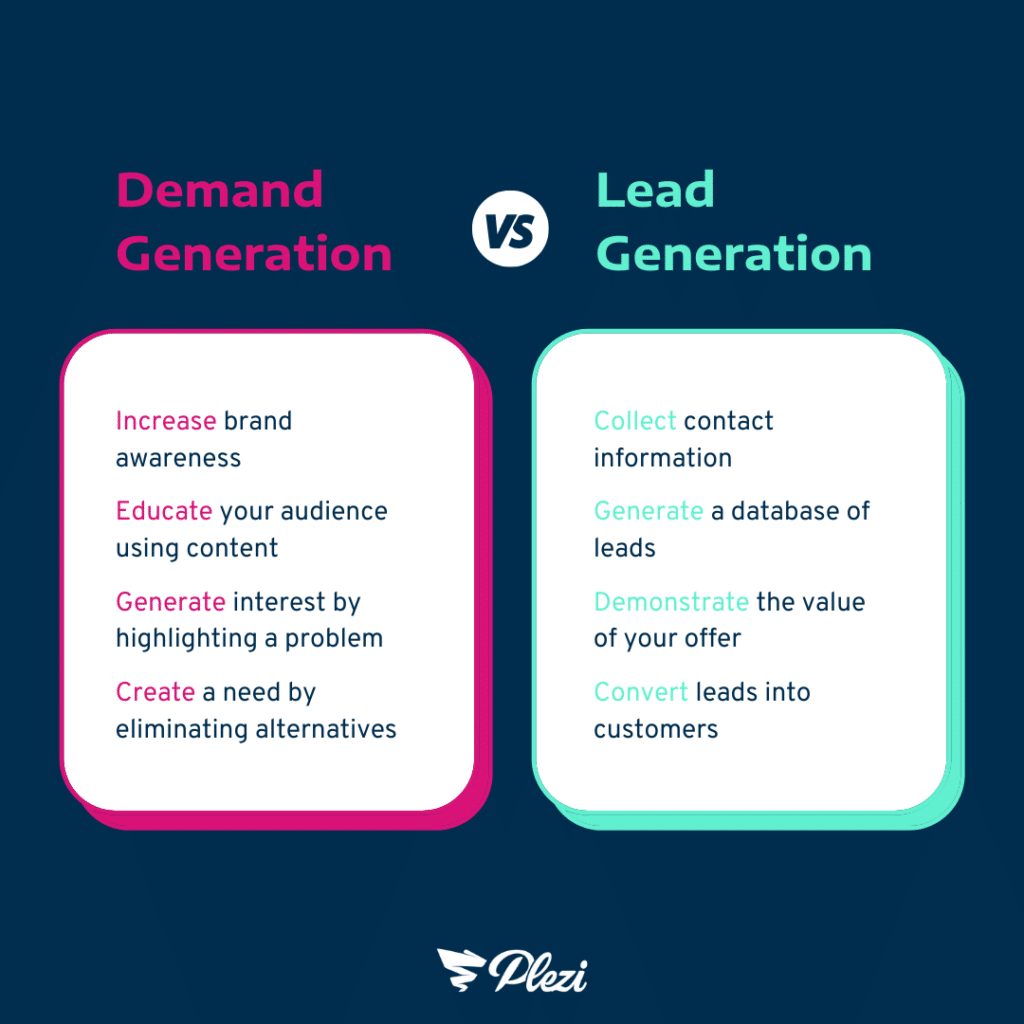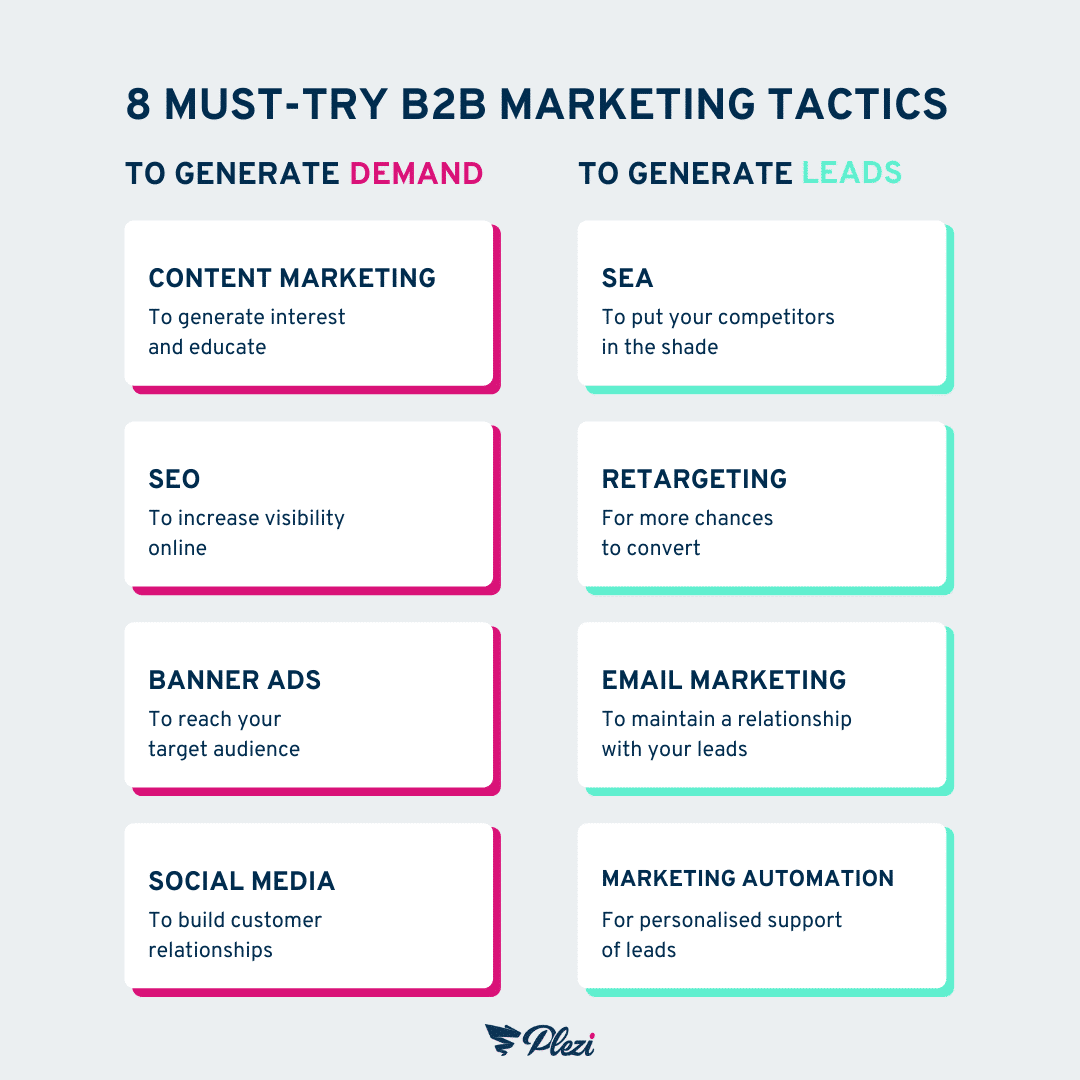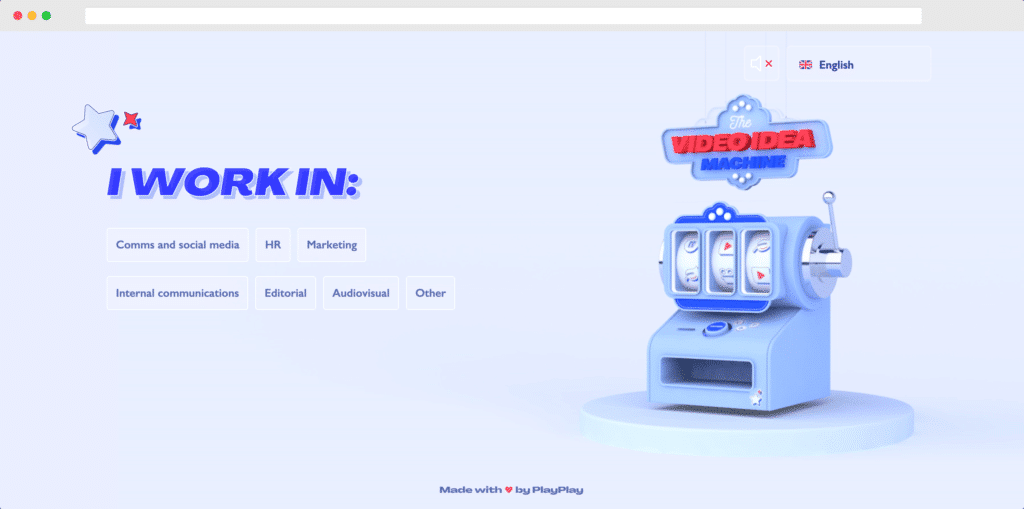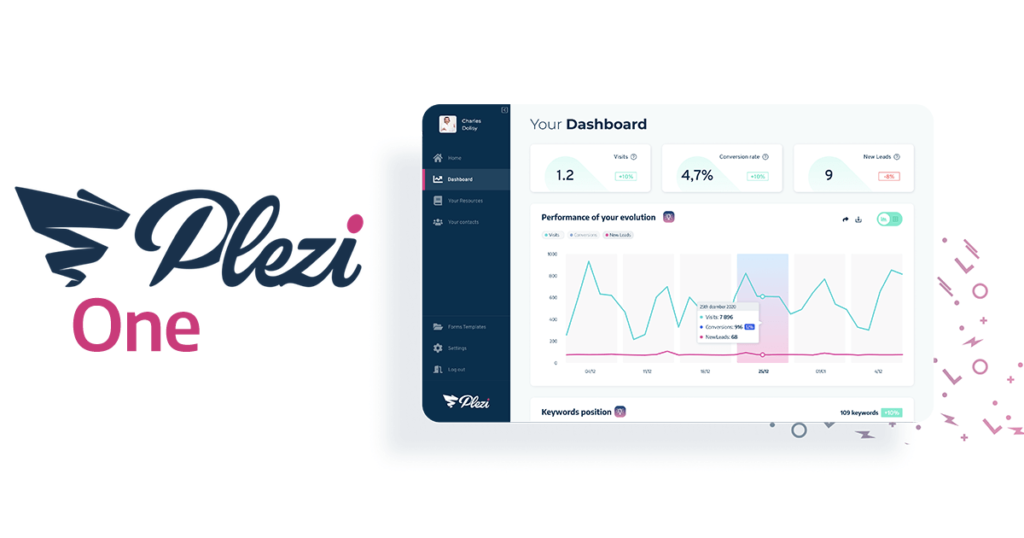What if you could increase brand awareness, get more leads who are ready to buy, and increase the number of leads you convert into customers? Sounds great, right? Well, demand generation will let you do all of this. And it’s an essential part of any good B2B sales and marketing strategy.
A strong demand generation programme helps increase sales revenue by nurturing good leads. Its goal is to strengthen brand awareness and authority by producing in-depth, engaging content that generates interest and nurtures leads. That’s why more and more companies are now looking to hire a demand generation manager.
But what exactly is the difference between demand generation and lead generation? And how can you best implement a demand generation strategy for your business? What are some real-world examples to inspire you?
We’ll tell you everything you need to know in the post below.
What is demand generation?
Demand generation is a strategy that creates awareness of, and demand for, your product or service.
Specifically, it involves increasing brand awareness and grabbing the attention of potential customers who know they have a problem, but don’t yet have a solution.
For example, let’s say that Sophie realizes her marketing team has too much on its plate. She doesn’t know it yet, but marketing automation can help her team save valuable time. As luck would have it, we happen to produce such software at Plezi! Our goal then is to make Sophie aware of our tool and generate demand for our product.
Because it’s not enough for your target audience to know that they have a problem. They also have to be aware of your solution. Only then will they be likely to take the plunge and make a purchase.
Inbound marketing: the key to successful demand generation
Any demand generation strategy worthy of the name takes into account each touch point in the buyer’s journey, from the anonymous website visitor to the satisfied customer.
This often involves providing your target audience with free resources to address an initial problem. By doing so, you can educate them about the more important problems they face and above all about the possible solution — your products or services.
It’s not surprising then that a demand generation strategy uses inbound marketing to generate interest in your offer.
Demand Generation vs Lead Generation
You should be careful not to confuse demand generation with lead generation. While a lot of terms in digital marketing can sound quite similar, these are two different strategies that address different stages in the buying cycle.
Lead generation is designed to convert your target audience into qualified leads. Demand generation aims to increase your audience by attracting new traffic to your website and introducing your solution to them.
Demand generation happens at the stage before lead generation and fuels the generation of leads.
Demand generation has several goals:
- Increase brand awareness
- Educate your target audience using inbound marketing
- Generate interest by highlighting a problem faced by your target audience
- Create a need by discouraging the choice of possible alternatives
The goals of lead generation are different:
- Collect contact information from your target audience
- Generate a database of leads at different stages in the sales cycle
- Demonstrate the value of your offer and how it differs from that of your competitors
- Convert leads into customers.
7 best practices for a successful demand generation strategy
1. Know your target audience
It’s now so important to listen to buyers at every stage of the sales funnel. To maintain a strong relationship with them, you need to know what their needs are.
The better you know your target audience, the easier you can attract them with targeted messages that address their needs. This will help you to position your company as an industry leader and guide your target audience on topics of interest to them.
That’s why it’s important to create buyer personas. These will help you identify their problems, obstacles, and frustrations, but also things like their aspirations and how they gather information.
Once you’ve generated leads, continue to learn from them and pay close attention to their changing needs.
This will let you nurture contacts more effectively. It will also let you segment them by demographics, interests, or needs, so you can provide them with information and content targeted to their specific needs.
2. Create content that highlights and addresses your target audience’s problems
Once you’ve understood the problem or problems faced by your target audience, you can start creating expert content that addresses these, e.g., time wasted at work, lack of effectiveness, limited resources.
This content can take many different forms, for example:
- blog posts;
- premium content like operational kits, guides, white papers on a specific topic;
- social media posts;
- speaking at physical events and on webinars;
- podcasts;
- FAQs;
The goal of a good content marketing strategy should be to provide your target audience with valuable, timely information at every stage of the buyer’s journey and enhance your expertise. Your audience will remember your business as subject matter experts and look to your company for their future needs.
The aim of all these actions is to build trust with leads and to lay the groundwork for the following conversation: the solutions your company can offer.
3. Provide resources that have real value
Most of us have probably bookmarked a range of free online tools that we regularly use because they are easy to access and get the job done. The vast majority of these, of course, are provided by companies looking to generate revenue!
That’s because providing a free online tool for people to use is one of the best demand generation tactics around. These can include things like templates, calculators, performance checkers, and other interactive tools. (By the way, have you seen our range of B2B marketing templates?)
If you create a valuable online tool that your target audience loves to use, you’ll find they won’t keep it to themselves. On the contrary, they’ll become the best brand ambassadors you could hope for within their network.
This is a winning strategy which will help you expand your reach with a relevant audience.
4. Be where your target audience is
Generating demand means attracting prospects to your website. And this involves speaking to them on the relevant channels they use.
Fortunately, there are marketing techniques that will help you do this:
- SEO: Writing blog posts on topics of interest to your prospects and optimizing this content for search engines is a great way to attract organic traffic to your website.
- Social media marketing: Given the amount of time now spent by internet users on social media, your business can’t afford not to have a social media presence if it wants to be visible online. This can make use your company’s social media accounts, your employees, business partners, or campaigns involving industry experts and brand ambassadors.
- External blogs and media: There are also some widely-viewed B2B industry websites and blogs available online. Why not sponsor a blog post or share a study on one of these channels? By doing so, you’ll be more likely to reach a much wider audience.
- Premium content: Premium content is content reserved for those who request it in exchange for certain information. That’s why it’s so important to have on your website. This can include e-books, guides, white papers, videos, or other content that is worth downloading because it provides value to visitors and contacts. A demand generation strategy is only successful when you convert a website visitor into a lead.
5. Educate leads
Demand generation doesn’t stop once visitors have given you their email address! You don’t generate leads to then ignore them.
A sound demand generation strategy requires a comprehensive process for moving leads closer to purchase, from when they the first make contact with your company to their decision to buy. Marketing must support a lead throughout their decision-making process using lead nurturing.
Has your target audience identified a problem to be addressed? That’s good news, but this is only the first step. You still have to present your solution to them and convince them that other solutions and alternatives are not suitable to their needs.
Lead nurturing lets you send your target audience the right content or resources at the exact time this information is most useful to them.
In order to turn these targeted contacts into customers, you need to segment your target audience and maintain your relationship with them. A marketing automation tool will let you automatically track the progress of leads trough the funnel and provide them with personalized content.
6. Use social proof to create demand
A sure-fire way to enhance your credibility with leads is to make use of recent reviews from genuine customers. Because nothing generates demand like testimonials from satisfied customers. This is something that is well-known by B2B marketers and is called social proof.
Taken individually, reviews and testimonials give direct feedback from customers linked to actual use of your product or service, without any marketing hype. Together, they provide a brief overview of your company’s product or service and help prospective buyers make their choice.
7. Measure your demand generation efforts
As always, if you want to ensure the money you spend on demand generation isn’t being wasted, you need to measure the outcome of your actions.
The data you use for this will vary depending on the nature of your business, your sales cycle, and your objectives. Nevertheless, there are certain metrics we recommend that you track which will help you get started:
- Close rate: this KPI tells you how many sales have been made compared to the number of leads generated.
- Cost per acquisition: use this figure to assess whether your demand generation strategy is cost-effective.
- Cost per lead: this figure will tell you how much your business spends to acquire a lead.
- Conversion rate: track the important conversion points in the buyer’s journey. For example, the conversion rate of your landing pages, forms, and calls to action (CTA).
- The time spent by leads at each stage of the buyer’s journey: this is a great indicator of whether your demand generation strategy is producing real results.
These metrics will give you a clear indication of whether you are targeting the right audience and whether your product or service is a good fit for the businesses you are in contact with.
Closely monitoring these KPIs will help you find any gaps in your process and give you ways to address these.
4 examples of successful B2B demand generation
1. Reassuring leads: PlayPlay’s video idea machine
Earlier, we talked about the benefits of providing a free online tool for potential customers to use. PlayPlay shows they have understood this with its video idea machine.
PlayPlay is a tool to create marketing videos. They’ve identified a potential obstacle for marketers wanting to use their tool, namely a lack of ideas for creating videos. The PlayPlay video idea machine addresses this problem, providing an additional source of inspiration to leads and customers.
2. Educating an audience: Canva’s Design School
“I’m afraid I don’t have the skills to make good use of your product.” Have you heard this objection before from a potential customer, or something like it? One way to overcome this is to educate your audience and show them that they can use your product or service successfully.
Knowing this, Canva seized the opportunity to create a graphic design training platform, proving that anyone can create great looking visuals with their tool.
3. Showing the loss of revenue: Pedro Cortes’s “Landing Page Teardown”
Agencies and freelancers don’t always have the resources to create free online tools. But they can make their expertise available online.
Pedro Cortes, a copywriter who specializes in writing landing pages, does exactly that. He regularly posts “Landing Page Teardown” videos in which he analyses the strengths and weaknesses of a particular landing page and what could be done to improve its performance.
His audience can even apply to have him analyse their landing page. By doing so, he demonstrates both the expertise of his agency and the potential loss of revenue of not using his services.
4. Addressing leads’ lack of resources: Plezi One
Another obstacle is lack of resources. Not all companies are able to hire more than one marketing person or invest a lot of money in a complex marketing strategy. And yet, very often a marketer needs to be supported by a team.
That’s why Plezi created a free tool to generate leads with these micro-businesses and SMEs in mind. Using Plezi One, you can generate leads and obtain specific figures to analyse your online marketing performance, without having to invest more in marketing.
A great way to promote your other products or services is to create one that anyone can use. If you can’t generate demand, it will be difficult to acquire new customers and grow your business.
A successful demand generation strategy is not measured simply by the number of leads you generate. Rather, it is measured over the long term based on the quality of the leads generated and what you can ultimately convert into revenue.
Finally, let’s recap:
What is demand generation?
Demand generation is a marketing strategy designed to improve brand awareness and to create a need for a company’s offer in order to attract qualified leads.
What’s the difference between demand generation and lead generation?
The goal of lead generation is to convert your target audience into leads. Demand generation aims to increase your target audience by attracting targeted traffic to your website and creating interest in your product or service.
What is the role of a demand generation manager?
Using their excellent knowledge of the company’s offer and target audience, they must identify content that will create a need, and generate demand as a result. They must then ensure that this content is created and distributed to the target audience using all relevant marketing channels and tactics.
How can demand generation actions be measured?
To measure the effectiveness of your demand generation strategy, you need to look at several different KPIs. These can include the close rate, cost per acquisition and per lead, or the time spent by leads at each stage of the buyer’s journey.










